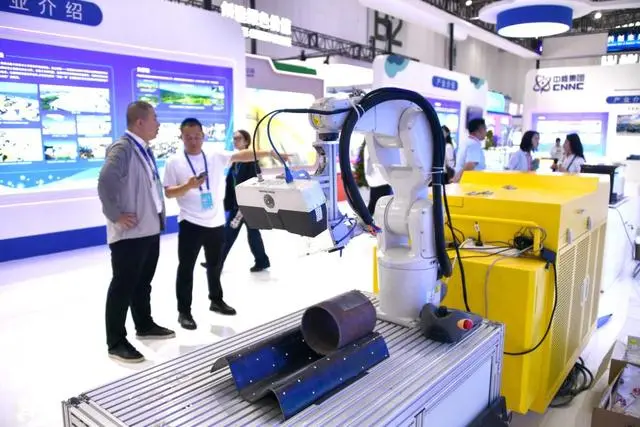Xinhua News Agency, Jinan, August 30 (Reporters Yuan Min, Zhang Wuyue) Solar photovoltaic panels have replaced traditional sunshades, and vertical-axis wind turbines rotate to provide wireless mobile phone charging for tourists in the pavilions below; on the south slope of the road, photovoltaic facilities stretch to the end of the horizon... In the Jinxiang Service Area of Zaohe Expressway in Shandong Province, the changes brought by the development of new energy can be seen everywhere.
This green highway with independent and controllable "energy supply, energy use and energy reception" has seen its Jinxiang section's road photovoltaic power generation reach over 5 million kWh during the trial operation stage, saving about 1,800 tons of standard coal and reducing carbon dioxide emissions by about 4,150 tons.
This is an example of China's vigorous promotion of green, low-carbon and high-quality development. On August 29, the 2023 Green, Low-Carbon and High-Quality Development Conference opened in Shandong, a major industrial province in China. Here, more "Chinese wisdom" contributed by China to global green development in terms of energy conservation, emission reduction and innovative development was showcased.

A high-power laser application equipment displayed at the Equipment Exhibition of the 2023 Green, Low-Carbon and High-Quality Development Conference (photographed on August 29). Photo by Xinhua News Agency reporter Xu Suhui
Data released by China's National Development and Reform Commission at the opening ceremony of the conference showed that in the past decade, China has supported an average annual GDP growth of 6.6% with an average annual energy consumption growth of 3%. Energy consumption per unit of GDP and carbon dioxide emissions have dropped by 26.2% and 34.4% respectively. The installed capacity of wind power, photovoltaics and hydropower all rank first in the world, and historic achievements have been made in green, low-carbon and high-quality development.
In promoting green and low-carbon development, scientific and technological innovation is a key support. At the opening ceremony of the conference, participants generally believed that as the pace of green and low-carbon development accelerates, giving play to the role of science and technology in reducing carbon emissions and promoting social green transformation has become a global consensus, with progress made in fields such as new energy vehicles, mining, batteries and shared electric bicycles.
In the production area of Block Lai 113 of Shengli Oilfield in Dongying, Shandong, under the blue sky and white clouds, two 10-meter-long, 4.4-meter-high, capsule-shaped white storage tanks are particularly eye-catching. It is reported that these are special gas storage tanks for the carbon capture, utilization and storage (CCUS) project, and also China's first skid-mounted mobile carbon dioxide injection equipment. The tank is under high pressure and low temperature, and can store 100 tons of carbon dioxide in liquid form.
CCUS is an important technical means to address global climate change. "It can effectively 'drive oil' to increase oil production; it can also make carbon dioxide stay underground permanently, achieving full closure and zero emissions," said Wu Jihui, head of the CCUS project department. At present, China's CCUS industry has begun to enter the stage of commercial operation. Shengli Oilfield has built 20 standardized injection stations with an annual injection capacity of 1 million tons.
Entering Donghua Technology Co., Ltd., a cement production enterprise in Zichuan District, Zibo, Shandong, every step of the enterprise's "carbon footprint" can be accurately captured. 8 categories and 339 sets of sensors, as well as digital twin technology, help the enterprise realize carbon metering, "carbon footprint" management and carbon accounting, which can save the enterprise 2 million yuan in carbon compliance costs, 18,000 tons of standard coal, and reduce carbon dioxide emissions by more than 20,000 tons a year.
In 2021, China released the *Action Plan for Carbon Dioxide Peaking Before 2030*, focusing on implementing the "Ten Actions for Carbon Peaking" such as the green and low-carbon transformation of energy, energy conservation, carbon reduction and efficiency improvement, carbon peaking in the industrial sector, carbon peaking in urban and rural construction, and green and low-carbon transportation, promoting China's low-carbon development to accelerate.
On August 29, visitors view a model of China's HL-2M Tokamak controllable nuclear fusion experimental device at the Equipment Exhibition of the 2023 Green, Low-Carbon and High-Quality Development Conference. Photo by Xinhua News Agency reporter Xu Suhui
Recently, at Zhongtong Bus Co., Ltd. in Liaocheng, Shandong, the first batch of 500 natural gas buses ordered by Kyrgyzstan was delivered and will be transported to the capital Bishkek by September 30.
In 2022, Bishkek purchased 120 such buses, which operated well for half a year, so it added an order for 1,000 buses to completely replace the original fuel buses.
"Green" is the business card of Chinese buses selling well in countries along the "Belt and Road Initiative", and it is also China's contribution to global sustainable development. From taking the lead in releasing the *China's National Implementation Plan for the 2030 Agenda for Sustainable Development*, to launching 10 low-carbon demonstration zones, 100 climate change mitigation and adaptation projects in developing countries, and implementing more than 200 foreign aid projects to address climate change; from initiating the establishment of the "Belt and Road" Green Development International Alliance to promoting the establishment of a global clean energy partnership... China is actively promoting green international cooperation.
Participants generally believed that in the future, China will continue to push the exploration of "dual carbon" to a higher level, actively explore the realization mechanism of ecological product value, carbon sink compensation and trading mechanisms, promote the shift from dual control of energy consumption to dual control of carbon emissions, accelerate the innovation of green and low-carbon technologies, strive to reduce carbon in development and achieve higher-quality development in carbon reduction, and accelerate the formation of a spatial pattern, industrial structure, production mode and lifestyle that save resources and protect the environment.
Source: Xinhua News Agency


